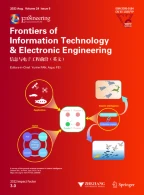Abstract
In this study, the finite-time formation control of multi-agent systems with region constraints is studied. Multiple agents have first-order dynamics and a common target area. A novel control algorithm is proposed using local information and interaction. If the communication graph is undirected and connected and the desired framework is rigid, it is proved that the controller can be used to solve the formation problem with a target area. That is, all agents can enter the desired region in finite time while reaching and maintaining the desired formation shapes. Finally, a numerical example is given to illustrate the results.
Similar content being viewed by others
References
Asimow L, Roth B, 1979. The rigidity of graphs, II. J Math Anal Appl, 68(1):171–190. https://doi.org/10.1016/0022-247X(79)90108-2
Basiri M, Bishop AN, Jensfelt P, 2010. Distributed control of triangular formations with angle-only constraints. Syst Contr Lett, 59(2):147–154. https://doi.org/10.1016/j.sysconle.2009.12.010
Bhat SP, Bernstein DS, 2000. Finite-time stability of continuous autonomous systems. SIAM J Contr Optim, 38(3):751–766. https://doi.org/10.1137/S0363012997321358
Dong XW, Hu GQ, 2016. Time-varying formation control for general linear multi-agent systems with switching directed topologies. Automatica, 73:47–55. https://doi.org/10.1016/j.automatica.2016.06.024
Dong XW, Xi JX, Lu G, et al., 2014. Formation control for high-order linear time-invariant multiagent systems with time delays. IEEE Trans Contr Netw Syst, 1(3): 232–240. https://doi.org/10.1109/TCNS.2014.2337972
Egerstedt M, Hu XM, 2001. Formation constrained multi-agent control. IEEE Trans Rob Autom, 17(6):947–951. https://doi.org/10.1109/70.976029
Erdös P, Rényi A, 1959. On random graphs I. Publ Math, 6:290–297.
Facchinei F, Pang JS, 2003. Finite-Dimensional Variational Inequalities and Complementarity Problems. Springer-Verlag, New York, USA, p.751–766. https://doi.org/10.1007/b97543
Fax JA, Murray RM, 2004. Information flow and cooperative control of vehicle formations. IEEE Trans Autom Contr, 49(9):1465–1476. https://doi.org/10.1109/TAC.2004.834433
Ge SS, Liu XM, Goh CH, et al., 2016. Formation tracking control of multiagents in constrained space. IEEE Trans Contr Syst Technol, 24(3):992–1003. https://doi.org/10.1109/TCST.2015.2472959
Hong YG, Wang JK, Cheng DZ, 2006. Adaptive finite-time control of nonlinear systems with parametric uncertainty. IEEE Trans Autom Contr, 51(5):858–862. https://doi.org/10.1109/TAC.2006.875006
Lafferriere G, Williams A, Caughman J, et al., 2005. Decentralized control of vehicle formations. Syst Contr Lett, 54(9):899–910. https://doi.org/10.1016/j.sysconle.2005.02.004
Li WX, Chen ZQ, Liu ZX, 2013. Leader-following formation control for second-order multiagent systems with time-varying delay and nonlinear dynamics. Nonl Dynam, 72(4):803–812. https://doi.org/10.1007/s11071-013-0754-6
Oh KK, Ahn HS, 2013. Formation control of mobile agents based on distributed position estimation. IEEE Trans Autom Contr, 58(3):737–742. https://doi.org/10.1109/TAC.2012.2209269
Oh KK, Park MC, Ahn HS, 2015. A survey of multi-agent formation control. Automatica, 53:424–440. https://doi.org/10.1016/j.automatica.2014.10.022
Porfiri M, Roberson DG, Stilwell DJ, 2007. Tracking and formation control of multiple autonomous agents: a two-level consensus approach. Automatica, 43(8):1318–1328. https://doi.org/10.1016/j.automatica.2007.01.004
Rezaee H, Abdollahi F, 2015. Pursuit formation of doubleintegrator dynamics using consensus control approach. IEEE Trans Ind Electron, 62(7):4249–4256. https://doi.org/10.1109/tie.2014.2384479
Sun Z, Mou S, Deghat M, et al., 2014. Finite time distance-based rigid formation stabilization and flocking. IFAC Proc Vol, 47(3):9183–9189. https://doi.org/10.3182/20140824-6-za-1003.00662
Xia YQ, Na XT, Sun ZQ, et al., 2016. Formation control and collision avoidance for multi-agent systems based on position estimation. ISA Trans, 61(9):287–296. https://doi.org/10.1016/j.isatra.2015.12.010
Xiao F, Wang L, Chen J, et al., 2009. Finite-time formation control for multi-agent systems. Automatica, 45(11):2605–2611. https://doi.org/10.1016/j.automatica.2009.07.012
Xie GM, Wang L, 2009. Moving formation convergence of a group of mobile robots via decentralised information feedback. Int J Syst Sci, 40(10):1019–1027. https://doi.org/10.1080/00207720902974603
Yang ZQ, Zhang Q, Chen ZQ, 2019. Formation control of multi-agent systems with region constraint. Complexity, 2019:8481060. https://doi.org/10.1155/2019/8481060
Author information
Authors and Affiliations
Corresponding author
Additional information
Project supported by the National Natural Science Foundation of China (Nos. 61573199 and 61571441)
Contributors
Zhengquan YANG and Xiaofang PAN designed the research and processed the data. Zhengquan YANG drafted the manuscript. Qing ZHANG and Zengqiang CHEN helped organize the manuscript. Zhengquan YANG and Xiaofang PAN revised and finalized the paper.
Compliance with ethics guidelines
Zhengquan YANG, Xiaofang PAN, Qing ZHANG, and Zengqiang CHEN declare that they have no conflict of interest.
Rights and permissions
About this article
Cite this article
Yang, Z., Pan, X., Zhang, Q. et al. Finite-time formation control for first-order multi-agent systems with region constraints. Front Inform Technol Electron Eng 22, 134–140 (2021). https://doi.org/10.1631/FITEE.2000177
Received:
Accepted:
Published:
Issue Date:
DOI: https://doi.org/10.1631/FITEE.2000177
